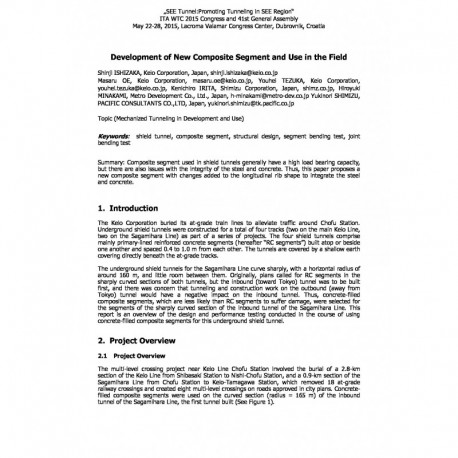Cart
0
0
No document
0,00 €
Total
Document successfully added to your shopping cart
Quantity
Total
There are 0 items in your cart.
There is 1 item in your cart.
Total documents
Total shipping
To be determined
Total
Search & filter
Search for a publication
Search & filter
Viewed documents
Development of New Composite Segment and Use in the Field
wtc2015_full_ishizaka
H. Minakami / S. Ishizaka / M. Oe / Y. Tezuka / K. Irita / Y. Shimizu
The Keio Corporation buried its at-grade train lines to alleviate traffic around Chofu Station. Underground shield tunnels were constructed for a total of four tracks (two on the main Keio Line, two on the Sagamihara Line) as part of a series of projects. The four shield tunnels comprise mainly primary-lined reinforced concrete segments (hereafter “RC segments”) built atop or beside one another and spaced 0.4 to 1.0 m from each other. The tunnels are covered by a shallow earth covering directly beneath the at-grade tracks. The underground shield tunnels for the Sagamihara Line curve sharply, with a horizontal radius of around 160 m, and little room between them. Originally, plans called for RC segments in the sharply curved sections of both tunnels, but the inbound (toward Tokyo) tunnel was to be built first, and there was concern that tunneling and construction work on the outbound (away from Tokyo) tunnel would have a negative impact on the inbound tunnel. Thus, concrete-filled composite segments, which are less likely than RC segments to suffer damage, were selected for the segments of the sharply curved section of the inbound tunnel of the Sagamihara Line. This report is an overview of the design and performance testing conducted in the course of using concrete-filled composite segments for this underground shield tunnel.




